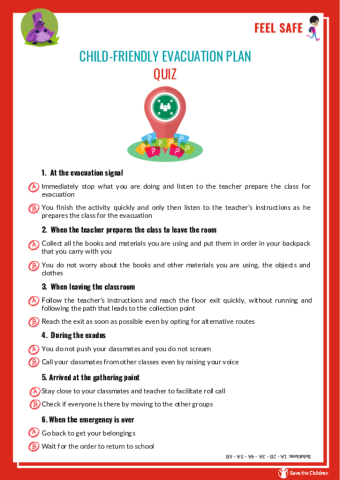Child-friendly Evacuation Plan
Objectives:
- Get to know your school and its signage
- Get to know how to orient yourself in case of an emergency
STEP BY STEP
BEFORE STARTING
Before beginning this activity, it's recommended to conduct an evacuation drill.
The teacher introduces the topic of understanding the school's emergency plan, providing the following definition from the glossary:
Evacuation Plan: An operational tool that outlines the actions to take during an emergency, including the route to follow for evacuation. In a school setting, this is referred to as the School Evacuation Plan.
The teacher prompts the class to discuss situations that might require leaving the classroom and what they remember from the evacuation drill, focusing on the evacuation plan. To encourage discussion, the following questions can be asked:
- Where are we, and what route should we take in an emergency?
- What signs do you recognize?
- What roles do people have in an emergency?
AN EYE ON THE PLAN
The teacher retrieves the classroom's emergency plan and explains its various components, highlighting how the information is useful to different individuals with various roles and responsibilities. Special attention is given to the section intended for students. Together, the class reads this section and discusses whether the instructions are clear and understandable.
QUIZ TIME!
The class focuses again on the section for students and reads it together. The teacher outlines the roles and behaviors typically included in emergency plans:
-
Roles Defined by the Plan:
- 2 Door Openers (1 leader, 1 substitute) to open doors and guide classmates to the gathering area.
- 2 Lockers (1 leader, 1 substitute) to assist classmates in need and close the classroom door after confirming everyone has exited.
- 2 Assistants (1 leader, 1 substitute) to help disabled classmates during the exit.
-
Behaviors in the Plan:
- Stop all ongoing activities.
- Do not collect backpacks or personal items.
- Line up and stay together during evacuation.
- Assume designated roles in the emergency plan.
- Follow the teacher's instructions calmly, even if the route changes.
To check understanding, the teacher distributes the quiz from the attachment "Child-Friendly Evacuation Plan An operational tool through which the operations to be carried out in the event of an emergency must be studied and planned. It includes the route to be followed in the event of an evacuation. At school it is called the School Evacuation Plan. - Quiz," where students select the correct answers from given options. The teacher prepares answer cards for later verification.
ILLUSTRATED PLAN
After the quiz, once correct answers are confirmed, students are divided into groups. Each group receives sentences from the emergency plan to illustrate on small cards. Together, these drawings will create a collage on a larger poster board. Each group will also write a simple caption under their illustration explaining the depicted action.
By the end of this activity, the class will have created a Child-Friendly Emergency Plan, which can be displayed on the classroom wall.
CONCLUDING THOUGHTS
The teacher emphasizes the importance of using accessible language to make crucial emergency documents easier to understand. To facilitate discussion, the teacher can ask:
- Are the directions in the plan clearer when represented with pictures?
- Before creating the Child-Friendly Plan, did you feel prepared to explain the emergency plan to another class?
- Now, do you feel ready to teach other classes how to behave in an emergency?

Add new comment